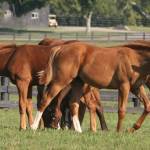A Peek at Real-World Growth Data of Thoroughbreds

Joe Pagan, Ph.D., president and founder of Kentucky Equine Research, recently gave a presentation titled “Thoroughbred Growth and Performance: An International Perspective” at Spy Coast Farm in Lexington, Kentucky.
In his presentation, Pagan compared growth statistics of foals born in the United States and in Europe. For the study, he used data from just over 1,400 American foals from 13 farms born between 2014 and 2018, and 1,700 European foals born on six farms between 2005 and 2019.
Growth data, including height and weight of foals, weanlings, and yearlings, is collected monthly and fed into Gro-Trac, specialty software designed by Kentucky Equine Research more than 20 years ago. Gro-Trac is a valuable management and communication tool used by breeding farms, consultants, and owners who cannot see their horses regularly but like to keep abreast of their development. The software is regularly updated to broaden its scope. In addition to growth information, performance data, including sales price and race record, is added as horses mature.
The data revealed that foals born in the United States are slightly heavier at birth, weighing an average of 124.7 lb, whereas foals born in Europe weigh in at 121.7 lb.
An interesting aspect of the study involved the incidence of osteochondritis dissecans, known colloquially as OCD. This developmental disorder may crop up for one or multiple reasons, including genetic predisposition, nutritional imbalance, and abnormal growth rate, and often causes problems for young horses as they age.
Pagan tracked radiographic survey data and found that foals out of maiden mares had 35% fewer OCD lesions than foals born of multiparous mares. Further, foals heavier than 139 lb at birth were two times more likely to have surgery for OCD than lighter foals and are less likely to become stakes winners, according to Pagan. Location of OCD surgeries indicated that hock lesions rarely affected sales and racing performance, but stifle lesions could be problematic.
With this data in mind, Pagan mentioned consistent surveillance of large foals by regular weighing right from birth. The mare should not be forgotten, said Pagan, and energy intake might need to be more closely regulated for mares that reliably produce large foals.








